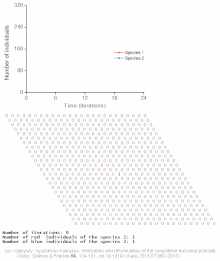Population model
A population model is a type of mathematical model that is applied to the study of population dynamics.
Rationale
Models allow a better understanding of how complex interactions and processes work. Modeling of dynamic interactions in nature can provide a manageable way of understanding how numbers change over time or in relation to each other. Many patterns can be noticed by using population modeling as a tool.[1]
Population models are used to determine maximum harvest for agriculturists, to understand the dynamics of
Another way populations models are useful are when species become endangered. Population models can track the fragile species and work and curb the decline. [1]
History
Late 18th-century biologists began to develop techniques in population modeling in order to understand the dynamics of growing and shrinking of all populations of living organisms.
Population modeling became of particular interest to biologists in the 20th century as pressure on limited means of sustenance due to increasing human populations in parts of Europe were noticed by biologist like
Equations
Competitive Lotka–Volterra equations:
Examples of individual-based models

See also
References
- ^ Worster, Donald (1994). Nature's Economy. Cambridge University Press. pp. 398–401.
- ^ a b Uyenoyama, Marcy (2004). Rama Singh (ed.). The Evolution of Population Biology. Cambridge University Press. pp. 1–19.
- ^ a b McIntosh, Robert (1985). The Background of Ecology. Cambridge University Press. pp. 171–198.
- ^ Renshaw, Eric (1991). Modeling Biological Populations in Space and Time. Cambridge University Press. pp. 6–9.
- ^ Kingsland, Sharon (1995). Modeling Nature: Episodes in the History of Population Ecology. University of Chicago Press. pp. 127–146.
- ^ Gotelli, Nicholas (2001). A Primer of Ecology. Sinauer.
External links
- GreenBoxes code sharing network. Greenboxes (Beta) is a repository for open-source population modeling code. Greenboxes allows users an easy way to share their code and to search for others shared code.




